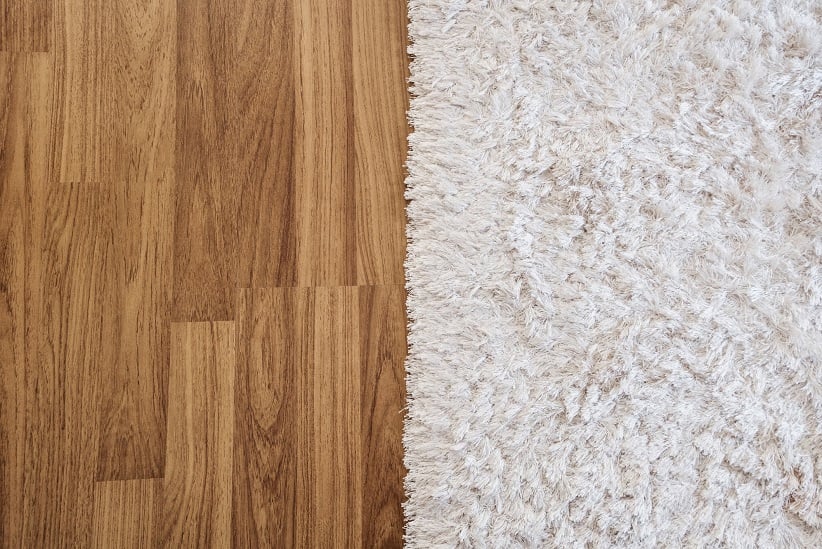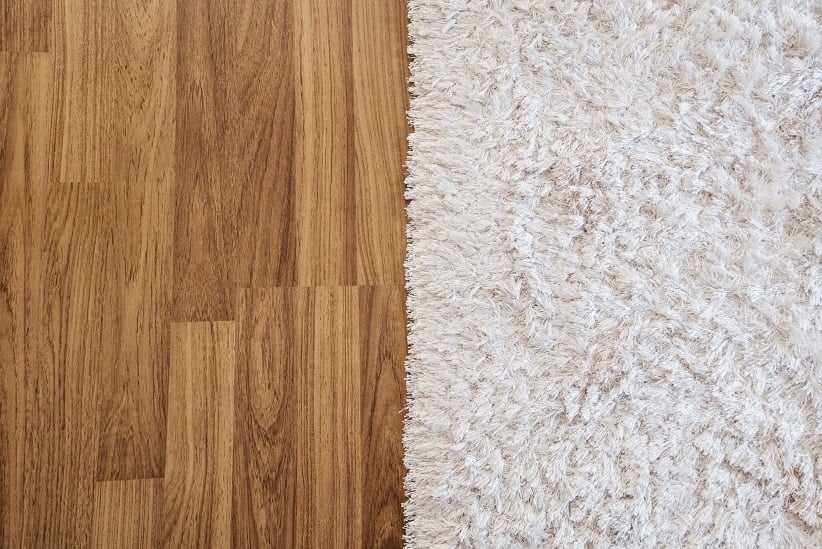Consider upgrading your flooring by replacing the outdated, worn carpet with sleek hardwood or elegant tile. Transitioning from carpet to hardwood or tile can be a transformative upgrade for your home. However, this process requires careful planning and execution to achieve stunning results. In this blog, we'll provide you with effective and informative tips for removing carpets and successfully transitioning to hardwood or tile flooring. Let's delve into the essential steps to ensure a seamless and rewarding flooring renovation.

Assess Your Space and Budget:
Before diving into the project, assess your space and budget. Determine the size of the area to be upgraded and factor in additional costs for materials, labor, and any necessary subfloor preparation. Having a clear understanding of your budget will help you make informed decisions and avoid unexpected expenses.
Prepare for Carpet Removal:
Clear the room of all furniture and belongings before starting the carpet removal process. Use a utility knife to cut the carpet into manageable sections and remove them along with the padding. Properly dispose of the old carpet and padding to make room for your new flooring.
Inspect the Subfloor:
With the carpet removed, carefully inspect the subfloor for any damage or imperfections. Fix any uneven or damaged areas to ensure a smooth and stable foundation for your new hardwood or tile flooring. A level subfloor is essential for a successful installation.
Choose the Right Flooring Material:
Selecting the appropriate hardwood or tile flooring is crucial for a successful transition. Consider factors such as the room's function, traffic levels, and design preferences. Hardwood flooring offers warmth and elegance, while tile provides durability and versatility. Make an informed decision based on your needs and style preferences.
Plan the Transition Areas:
When transitioning from carpet to hardwood or tile, you'll need to plan the transition areas between the different flooring materials. Thresholds or transition strips can create a smooth and seamless flow between rooms. Ensure that these transitions are properly installed to prevent trip hazards and maintain the visual appeal of your new flooring.
Professional Installation:
While DIY projects can be rewarding, enlisting the help of a professional flooring installer can guarantee a flawless and long-lasting finish. Expert installers have the knowledge and experience to handle complex transitions and ensure a precise installation, saving you time and potential headaches.
Post-Installation Care:
After your new hardwood or tile flooring is installed, it's crucial to practice proper care and maintenance. Follow manufacturer guidelines for cleaning and maintenance to preserve the beauty and longevity of your flooring investment.
What Are The Steps Involved In Removing Carpet And Preparing For Hardwood Or Tile Flooring Installation?

Removing carpet and preparing for hardwood or tile flooring installation requires careful planning and attention to detail. Here are the essential steps involved in the process:
- Clear the Room:
Remove all furniture, decorations, and other belongings from the room to create a clear and open space for the carpet removal process. This step ensures that the installation team has sufficient room to work efficiently.
- Gather the Necessary Tools:
Before starting, gather the necessary tools for carpet removal, including a utility knife, pliers, pry bar, and work gloves. These tools will help you remove the carpet and padding effectively.
- Cut and Roll the Carpet:
Using a utility knife, cut the carpet into manageable sections, typically about 3-4 feet wide. Carefully roll up each section as you cut, exposing the carpet padding underneath.
- Remove Carpet and Padding:
With the carpet rolled up, use pliers to pull up the carpet from the tack strips around the perimeter of the room. If the carpet is stapled, remove the staples using the pliers. Continue to roll up and remove the carpet and padding until the entire room is cleared.
- Inspect the Subfloor:
Once the carpet and padding are removed, inspect the subfloor for any damages or imperfections. Address any issues such as squeaks, uneven spots, or damage before proceeding with the installation of hardwood or tile.
- Remove Adhesive and Staples:
If there is any adhesive or residual padding-left on the subfloor, use a scraper or adhesive remover to clean the surface thoroughly. Additionally, check for any remaining staples or nails and remove them to create a smooth and clean surface for the new flooring.
- Level the Subfloor:
Ensure that the subfloor is level and free from any bumps or irregularities. If necessary, use a leveling compound to even out the surface, ensuring a proper foundation for the hardwood or tile installation.
- Acclimate the New Flooring:
If you're installing hardwood flooring, it's essential to acclimate the wood planks to the room's environment before installation. Leave the flooring material in the room for a few days to adjust to the temperature and humidity levels.
- Begin the Installation:
Follow the manufacturer's guidelines and recommendations for installing hardwood or tile flooring. Depending on the material, this process may involve an adhesive application, nailing, or a floating floor installation. Ensure that you start the installation from a straight and squared edge for a professional-looking finish.
- Install Transition Pieces:
As you install the new flooring, consider any transition areas where the hardwood or tile meets other flooring types, such as carpet or existing tile. Use appropriate transition pieces or molding to create a smooth and seamless transition between the different materials.
- Finish and Clean Up:
After completing the installation, clean up the area thoroughly, removing any debris or leftover materials. Sweep or vacuum the new flooring to eliminate any dust or dirt. If necessary, apply any recommended finishing treatments for hardwood or grout and sealant for tile.
Following these steps will help ensure a successful transition from carpet to hardwood or tile flooring, leaving you with a beautiful and durable new surface to enjoy in your home. If you are unsure or uncomfortable with any part of the process, it's best to consult a professional flooring installer for assistance.
How Can I Effectively Clean And Maintain My New Hardwood Or Tile Flooring After Installation?

Effectively cleaning and maintaining your new hardwood or tile flooring is essential to preserve its beauty and durability for years to come. Here are some valuable tips to help you care for your flooring investment:
- Daily Sweeping or Dust Mopping:
Regularly sweep or dust mop your hardwood or tile flooring to remove dust, dirt, and debris. This simple practice helps prevent scratches and keeps the surface looking clean and polished.
- Vacuum with Soft Bristles:
For hardwood floors, use a vacuum with soft bristles or a hardwood floor attachment to pick up fine particles and avoid any potential scratching. Be cautious with vacuums that have rotating brushes, as they may cause damage to hardwood floors.
- Clean Up Spills Immediately:
Accidents happen, but it's crucial to clean up spills and messes promptly to prevent moisture from seeping into the flooring. Use a soft, damp cloth to wipe up spills immediately to avoid potential damage or staining.
- Use Recommended Cleaning Products:
Refer to the manufacturer's guidelines for recommended cleaning products specifically designed for hardwood or tile floors. Avoid using harsh chemicals or abrasive cleaners, as they can strip away protective finishes or damage tile grout.
- Avoid Excessive Water:
When cleaning tile flooring, be cautious not to use excessive water, especially in the grout lines. Too much water can weaken grout and cause tiles to become loose over time. Opt for a damp mop rather than soaking the entire floor.
- Use Area Rugs and Mats:
Place area rugs or mats in high-traffic areas, near entryways, and in front of kitchen sinks to protect your flooring from scratches, spills, and dirt. These rugs also help reduce wear and tear in heavily used areas.
- Trim Pet Nails:
If you have pets, keep their nails trimmed regularly to avoid scratches on hardwood or tile surfaces. Pet nails can leave marks, particularly on softer wood species or unglazed tiles.
- Use Felt Pads and Furniture Protectors:
Attach felt pads to the bottom of furniture legs and use furniture protectors to prevent scratches and dents when moving or rearranging items on the floor.
- Consider Regular Maintenance:
Depending on the level of foot traffic, consider scheduling professional maintenance for your hardwood or tile flooring every few years. This maintenance may involve recoating hardwood floors or resealing tile grout to keep them in optimal condition.
- Protect Floors from Sunlight:
Direct sunlight can cause fading and discolouration on both hardwood and tile floors. Use curtains or blinds to protect the flooring from excessive exposure to sunlight.
By implementing these cleaning and maintenance practices, you can extend the life and beauty of your new hardwood or tile flooring, ensuring that it remains a source of pride in your home for years to come. Regular care and attention will pay off in the long run, keeping your floors looking elegant and well-preserved.
Final Thoughts On Tips for Removing Carpet and Transitioning to Hardwood or Tile Flooring

Transitioning from carpet to hardwood or tile flooring can breathe new life into your home and elevate its aesthetic appeal. By carefully planning, preparing, and executing the removal process, you can achieve stunning results that enhance the overall value of your space. Choose the right flooring material, plan transition areas, and consider professional installation to ensure a seamless and successful flooring renovation. With proper care and maintenance, your new hardwood or tile flooring will be a timeless investment that brings joy and beauty to your home for years to come.
Other flooring blog articles you may want to read:
How To Choose The Best Flooring For Your Home
Flooring Care and Maintenance Tips For Your Home And Office
